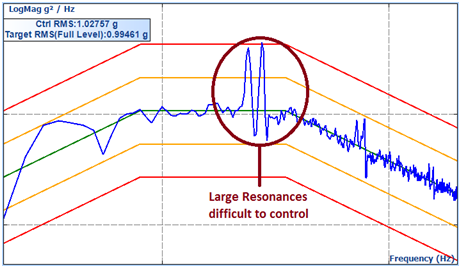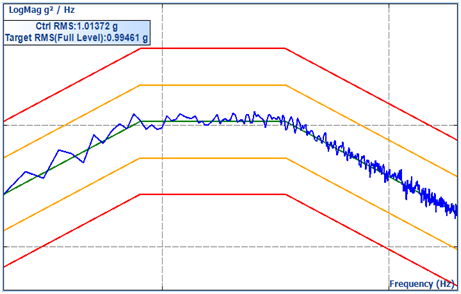Random Control Feature: Non-Linear Control
Download PDF | © Copyright Crystal Instruments 2016, All Rights Reserved.
During vibration control, it is often inevitable for the user to encounter the non-linearity issue. This non-linearity could originate from the shaker system, especially in the case of hydraulic shakers; or could be from the resonance characteristics of the device under test.
A hydraulic driven shaker usually has very strong non-linear characteristics. The estimated transfer function during the pre-test stage does not completely represent the characteristics of the system. This is due to the typically low level test that is run during the pretest. As the vibration level changes, the hydraulic shaker system transfer function changes accordingly. This will result in a little difficult control time for many of the conventional vibration control systems.
When the device under test has resonances within the control frequency band, the windowing as well as the other DSP applied during data acquisition/processing also introduces a non-linear effect into the control loop. This will result in an increased difficulty to control the adjacent region of the resonances.
Under the above mentioned circumstances, typical control strategies will likely have issues in achieving high accuracy of control. To tackle this type of challenge, Crystal Instruments’ Random Control implements an advanced algorithm which compensates for the effect of non-linearity in the control loop, regardless of whether it is caused by the type of shaker system or the resonance of the device under test.
On the EDM Random control software configuration panel, under the “Test” parameter tab, there is an “Advanced Setting” button. Check the box next to “Non-Linear control” to put the algorithm into effect.
With “Non-Linear Control” checked, it will enable the advanced control algorithm that compensates for the non-linearity response within the test system. For vibration tests on any shaker systems including a hydraulic shaker, or any devices having resonance within the control frequency band, this will significantly improve the control performance. This option should be left checked for all tests. Since this is the factory default setting, it will be very rare that this option would need to be unchecked.
The following control result is from a test with Non-Linear control unchecked on a DUT (device under test) with a resonance frequency within the control frequency band. It is obvious that the control accuracy is low around the resonance frequency neighborhood.
Run the same test with the same configuration, and check the “Non-Linear control” box. As illustrated in the follow control display, the control over the whole frequency band is within much tighter tolerances.



